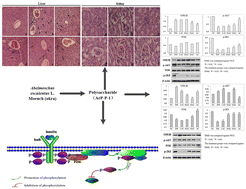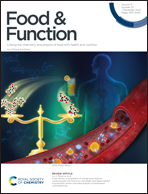Structural characterization of a polysaccharide from Abelmoschus esculentus L. Moench (okra) and its hypoglycemic effect and mechanism on type 2 diabetes mellitus†
Abstract
A novel acidic polysaccharide named AeP-P-1 was prepared from Abelmoschus esculentus L. Moench (okra). AeP-P-1 is a heteropolysaccharide with a molecular weight of 3.02 × 103 kDa and is composed of L-rhamnose, D-galactose, and D-galacturonic acid in the ratio 1.87 : 3.58 : 1.00. Structural characterization based on methylation and 1D/2D NMR analyses indicated that AeP-P-1 is composed of T-linked-Rhap, T-linked-Galp, 1,2,4-linked-Rhap, 1,4-linked-Galp, 1,6-linked-Galp, and 1,3,4-linked-Galp in a molar ratio of 2.42 : 3.36 : 6.46 : 13.31 : 3.12 : 1, respectively. The hypoglycemic effect and mechanism of AeP-P-1 on type 2 diabetes mellitus were also explored. Firstly, AeP-P-1 can reduce blood lipids and liver and kidney damage caused by T2DM. Finally, AeP-P-1 induces the phosphorylation of GSK3β, maintains the activity of glycogen synthase (GCS), and promotes glycogen synthesis by regulating the expression of insulin/PI3K/Akt pathway proteins. These results indicated that AeP-P-1 could be developed as a potential ingredient in immunostimulatory agents.

- This article is part of the themed collection: Food & Function HOT Articles 2022


 Please wait while we load your content...
Please wait while we load your content...